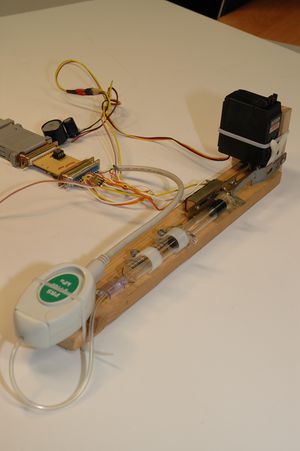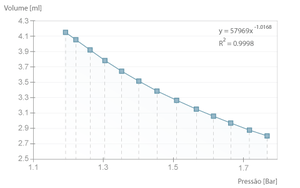Difference between revisions of "Boyle-Mariotte Law"
m (moved Verification of the Boyle-Mariotte Law to Boyle-Mariotte Law) |
(Remoção de secções colapsáveis e secções vazias e adição das imagens e do flash na descrição) |
||
| Line 1: | Line 1: | ||
| − | + | =Description of the Experiment= | |
The purpose of this experiment is to verify the relation \( p \propto \frac{1}{V} \) (i.e., pressure and volume are inversely proportional) of a gas during isothermal expansion or compression. | The purpose of this experiment is to verify the relation \( p \propto \frac{1}{V} \) (i.e., pressure and volume are inversely proportional) of a gas during isothermal expansion or compression. | ||
| + | |||
| + | <swf height="270" width="510">http://www.elab.tecnico.ulisboa.pt/anexos/descricoes-flash/BoyleMariottePV.swf</swf> | ||
| + | |||
<div class="toccolours mw-collapsible mw-collapsed" style="width:800px"> | <div class="toccolours mw-collapsible mw-collapsed" style="width:800px"> | ||
| + | '''Ligações''' | ||
| + | <div class="mw-collapsible-content"> | ||
| − | + | *Video: rtsp://elabmc.ist.utl.pt/pv.sdp | |
| + | *Laboratório: Básico em e-lab.ist.eu[http://e-lab.ist.eu] | ||
| + | *Sala de controlo: pv | ||
| + | *Nivel: ** | ||
| + | |||
| + | </div> | ||
| + | </div> | ||
| + | |||
| + | <div class="toccolours mw-collapsible mw-collapsed" style="width:800px"> | ||
| + | '''Ligações''' | ||
<div class="mw-collapsible-content"> | <div class="mw-collapsible-content"> | ||
| + | |||
| + | *Video: rtsp://elabmc.ist.utl.pt/boyle_mariotte.sdp | ||
| + | *Laboratório: Básico em e-lab.ist.eu[http://e-lab.ist.eu] | ||
| + | *Sala de controlo: Boyle-Mariotte | ||
| + | *Nivel: ** | ||
| + | |||
| + | </div> | ||
| + | </div> | ||
| + | |||
| + | =Experimental Apparatus= | ||
The apparatus is composedy by a cylinder filled with air, whose embolus is displaced by a servo motor, implemented with a 5 ml syringe. | The apparatus is composedy by a cylinder filled with air, whose embolus is displaced by a servo motor, implemented with a 5 ml syringe. | ||
| − | [ | + | [[File:Boyle-mariotte-montagem.jpg|thumb|alt=Experimental setup|Setup]] |
| − | It's possible to choose the limits for the compression/expansion of the chamber and get the air pressure and volume values inside it during the piston's motion. The speed at which the transformation occurs can also be specified by choosing the time between samples. | + | It's possible to choose the limits for the compression/expansion of the chamber and get the air pressure and volume values inside it during the piston's motion. The speed at which the transformation occurs can also be specified by choosing the time between samples. |
| − | |||
| − | |||
| − | + | =Protocol= | |
| − | |||
The user must specify the initial and final volume, the number of samples and time interval between them. This last option indirectly defines the speed at which the transformation occurs. | The user must specify the initial and final volume, the number of samples and time interval between them. This last option indirectly defines the speed at which the transformation occurs. | ||
| Line 23: | Line 44: | ||
The example bellow is such a case, where we can verify that the product \( pV \) is, in average, \( 49,3 \pm 0,3 l.kPa \), close to the theoretical value of \( nRT \) (where \( n = 2 \times 10 ^{-4} mol\), equivalent to the full syringe volume when in rest \( 5 ml \), PTN). | The example bellow is such a case, where we can verify that the product \( pV \) is, in average, \( 49,3 \pm 0,3 l.kPa \), close to the theoretical value of \( nRT \) (where \( n = 2 \times 10 ^{-4} mol\), equivalent to the full syringe volume when in rest \( 5 ml \), PTN). | ||
| − | [ | + | [[File:Boyle-mariotte-graf1.png|thumb|Graphical fit with experimental results with 1 sec. between samples.]] |
If the time between samples is decreased (i.e. the process is faster), the transformation is no longer isothermal and becomes slight adiabatic, because there is not enough time for heat exchange between the inside of the cylinder and the environment. In this way, the compression no longer follows the Boyle-Mariotte, a fact that is clearly demonstrated by the deviation from the power function, which would be \( ^3/_5 \) in the ideal case (\( \gamma ^{-1} = \frac{c_v}{c_p} \)). | If the time between samples is decreased (i.e. the process is faster), the transformation is no longer isothermal and becomes slight adiabatic, because there is not enough time for heat exchange between the inside of the cylinder and the environment. In this way, the compression no longer follows the Boyle-Mariotte, a fact that is clearly demonstrated by the deviation from the power function, which would be \( ^3/_5 \) in the ideal case (\( \gamma ^{-1} = \frac{c_v}{c_p} \)). | ||
| − | It is, however, difficult to obtain a fast enough compression to achieve this value, since thermalization occurs quickly (in the order of the speed of sound), but this can be used to study how the speed of the transformation influences the deviation between the experimental data and Boyle-Mariotte Law. | + | It is, however, difficult to obtain a fast enough compression to achieve this value, since thermalization occurs quickly (in the order of the speed of sound), but this can be used to study how the speed of the transformation influences the deviation between the experimental data and Boyle-Mariotte Law. |
| − | + | ||
| − | |||
| − | + | =Advanced Protocol= | |
| − | |||
With a high enough time between samples, it is also possible to determine the Ideal Gas Constant, if we consider room temperature to be 22ºC. | With a high enough time between samples, it is also possible to determine the Ideal Gas Constant, if we consider room temperature to be 22ºC. | ||
| Line 40: | Line 59: | ||
# Assume the room temperature to be 22ºC. Determine the amount of substance (in mole) present at the inicial stage of the experiment ( \( 5 ml \) of air at NTP conditions). Find R. | # Assume the room temperature to be 22ºC. Determine the amount of substance (in mole) present at the inicial stage of the experiment ( \( 5 ml \) of air at NTP conditions). Find R. | ||
# Compare the value for R that was found through this method with the one found through the average product of \( pV \) (using a math software, determine the product between p and V for each line and then find the average). | # Compare the value for R that was found through this method with the one found through the average product of \( pV \) (using a math software, determine the product between p and V for each line and then find the average). | ||
| − | # Find one last estimate for R find setting the exponent at -1 (i.e., fitting the data to a \( a x ^{-1} \) function) | + | # Find one last estimate for R find setting the exponent at -1 (i.e., fitting the data to a \( a x ^{-1} \) function). |
| − | |||
| − | |||
| − | |||
| − | |||
| − | |||
| − | |||
| − | |||
| − | |||
| − | |||
| − | |||
| − | |||
| − | |||
| − | |||
| − | |||
| − | |||
| − | |||
| − | |||
| − | |||
| − | |||
| − | |||
| − | |||
| − | |||
Revision as of 18:56, 20 May 2012
Description of the Experiment
The purpose of this experiment is to verify the relation \( p \propto \frac{1}{V} \) (i.e., pressure and volume are inversely proportional) of a gas during isothermal expansion or compression.
<swf height="270" width="510">http://www.elab.tecnico.ulisboa.pt/anexos/descricoes-flash/BoyleMariottePV.swf</swf>
Ligações
- Video: rtsp://elabmc.ist.utl.pt/pv.sdp
- Laboratório: Básico em e-lab.ist.eu[1]
- Sala de controlo: pv
- Nivel: **
Ligações
- Video: rtsp://elabmc.ist.utl.pt/boyle_mariotte.sdp
- Laboratório: Básico em e-lab.ist.eu[2]
- Sala de controlo: Boyle-Mariotte
- Nivel: **
Experimental Apparatus
The apparatus is composedy by a cylinder filled with air, whose embolus is displaced by a servo motor, implemented with a 5 ml syringe.
It's possible to choose the limits for the compression/expansion of the chamber and get the air pressure and volume values inside it during the piston's motion. The speed at which the transformation occurs can also be specified by choosing the time between samples.
Protocol
The user must specify the initial and final volume, the number of samples and time interval between them. This last option indirectly defines the speed at which the transformation occurs.
If the experiment is executed with a o long time interval between samples, the transformation is isothermal. That means the air temperature inside the syringe doesn't change, and the Boyle-Mariotte Law is applicable.
The example bellow is such a case, where we can verify that the product \( pV \) is, in average, \( 49,3 \pm 0,3 l.kPa \), close to the theoretical value of \( nRT \) (where \( n = 2 \times 10 ^{-4} mol\), equivalent to the full syringe volume when in rest \( 5 ml \), PTN).
If the time between samples is decreased (i.e. the process is faster), the transformation is no longer isothermal and becomes slight adiabatic, because there is not enough time for heat exchange between the inside of the cylinder and the environment. In this way, the compression no longer follows the Boyle-Mariotte, a fact that is clearly demonstrated by the deviation from the power function, which would be \( ^3/_5 \) in the ideal case (\( \gamma ^{-1} = \frac{c_v}{c_p} \)).
It is, however, difficult to obtain a fast enough compression to achieve this value, since thermalization occurs quickly (in the order of the speed of sound), but this can be used to study how the speed of the transformation influences the deviation between the experimental data and Boyle-Mariotte Law.
Advanced Protocol
With a high enough time between samples, it is also possible to determine the Ideal Gas Constant, if we consider room temperature to be 22ºC.
Procedure:
- Run the experiment with about 20 acquisitions, maximum extension between initial and final volume and maximum acquisition time allowed (we are trying to achieve an isothermal transformation).
- Fit the experimental data to a \( a x ^b \) type function and find the proportion constant (which will equal \( nRT \)).
- Assume the room temperature to be 22ºC. Determine the amount of substance (in mole) present at the inicial stage of the experiment ( \( 5 ml \) of air at NTP conditions). Find R.
- Compare the value for R that was found through this method with the one found through the average product of \( pV \) (using a math software, determine the product between p and V for each line and then find the average).
- Find one last estimate for R find setting the exponent at -1 (i.e., fitting the data to a \( a x ^{-1} \) function).

